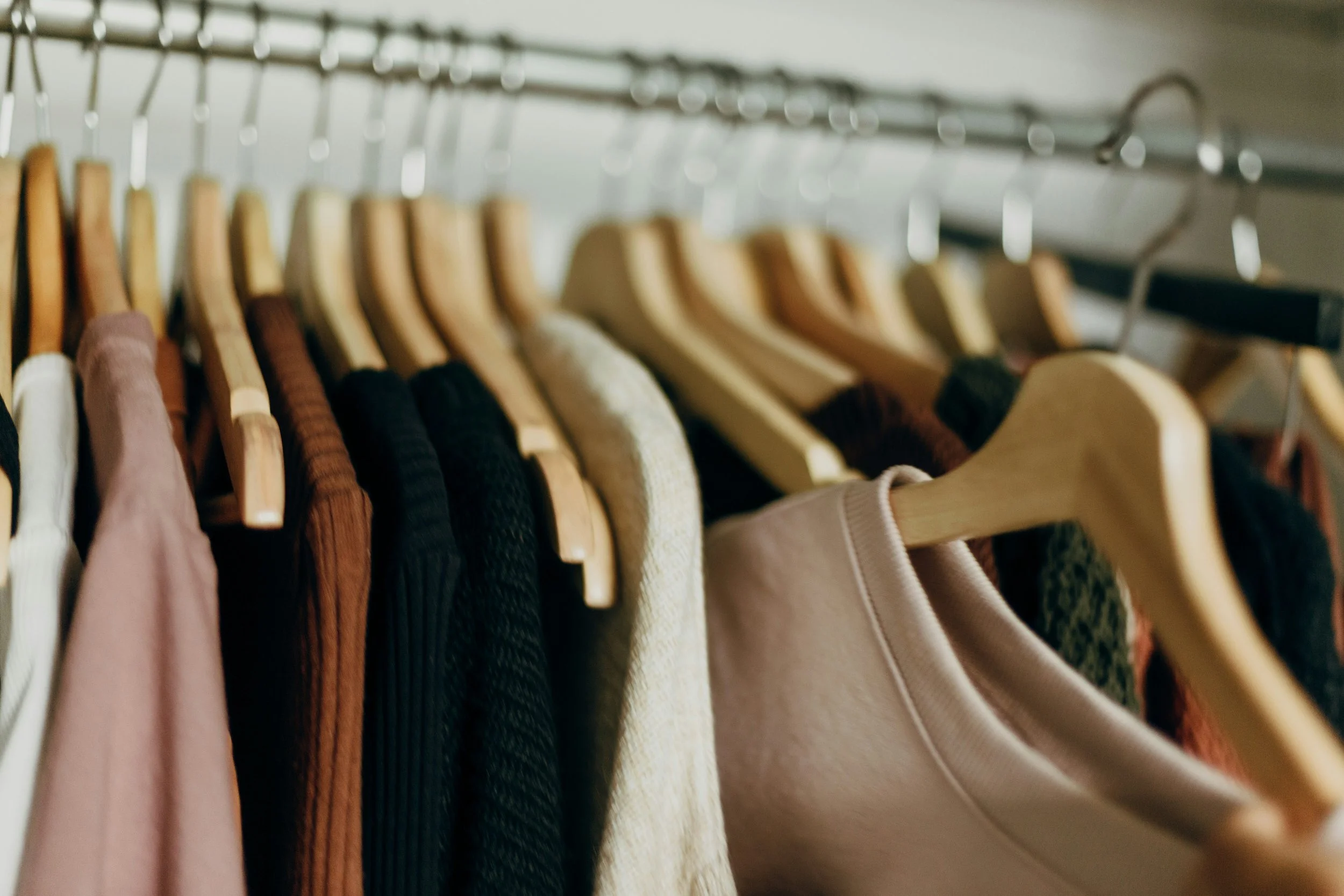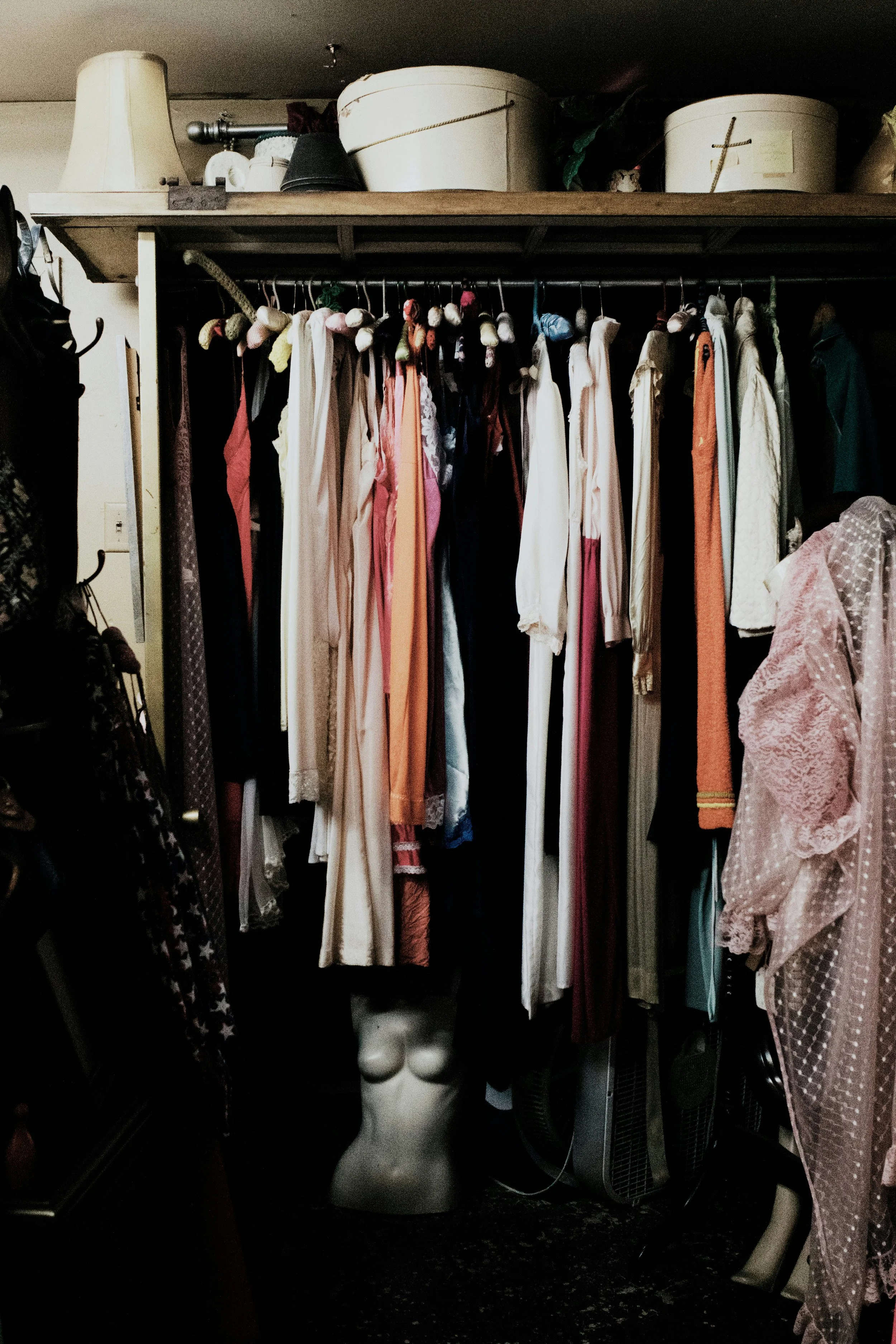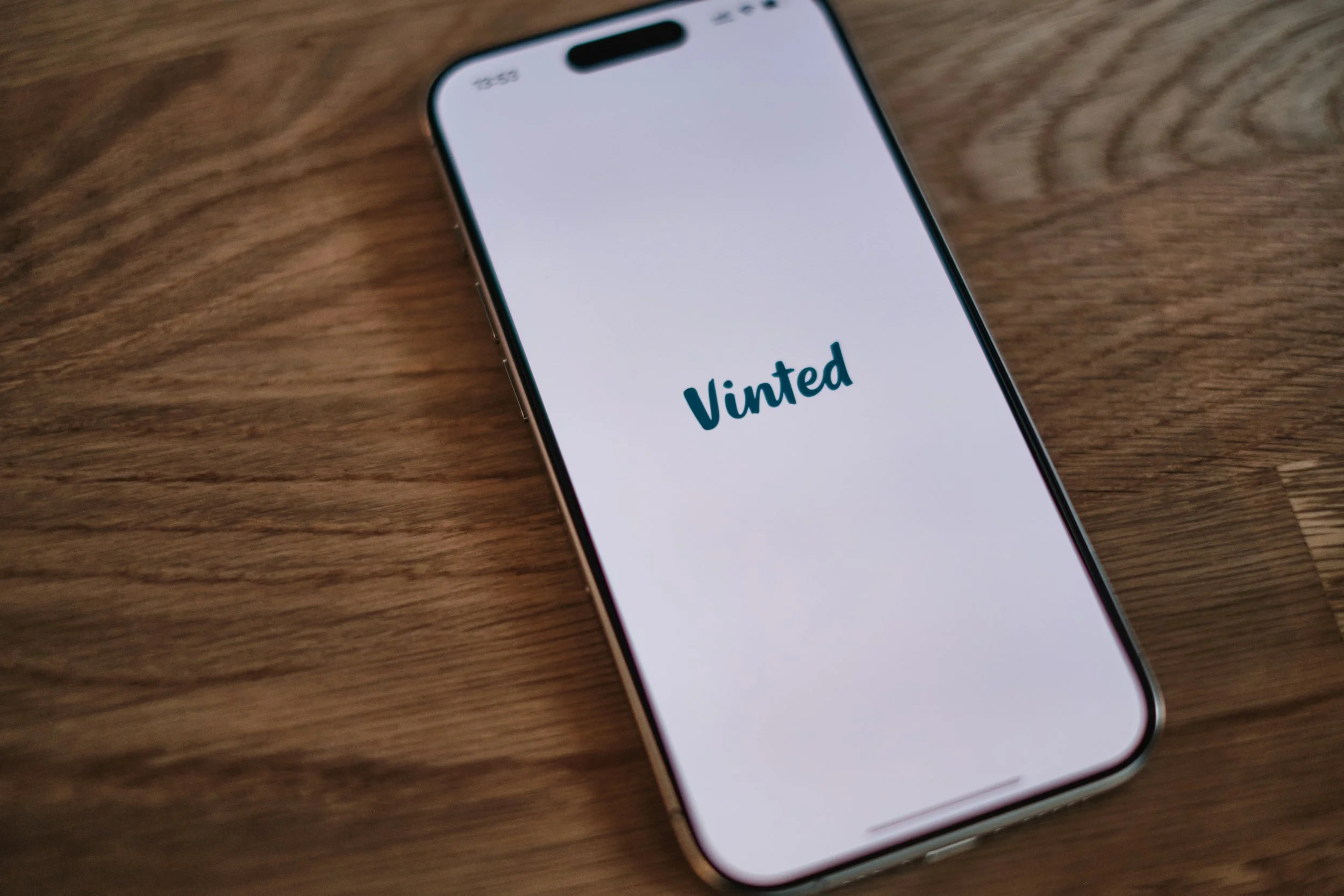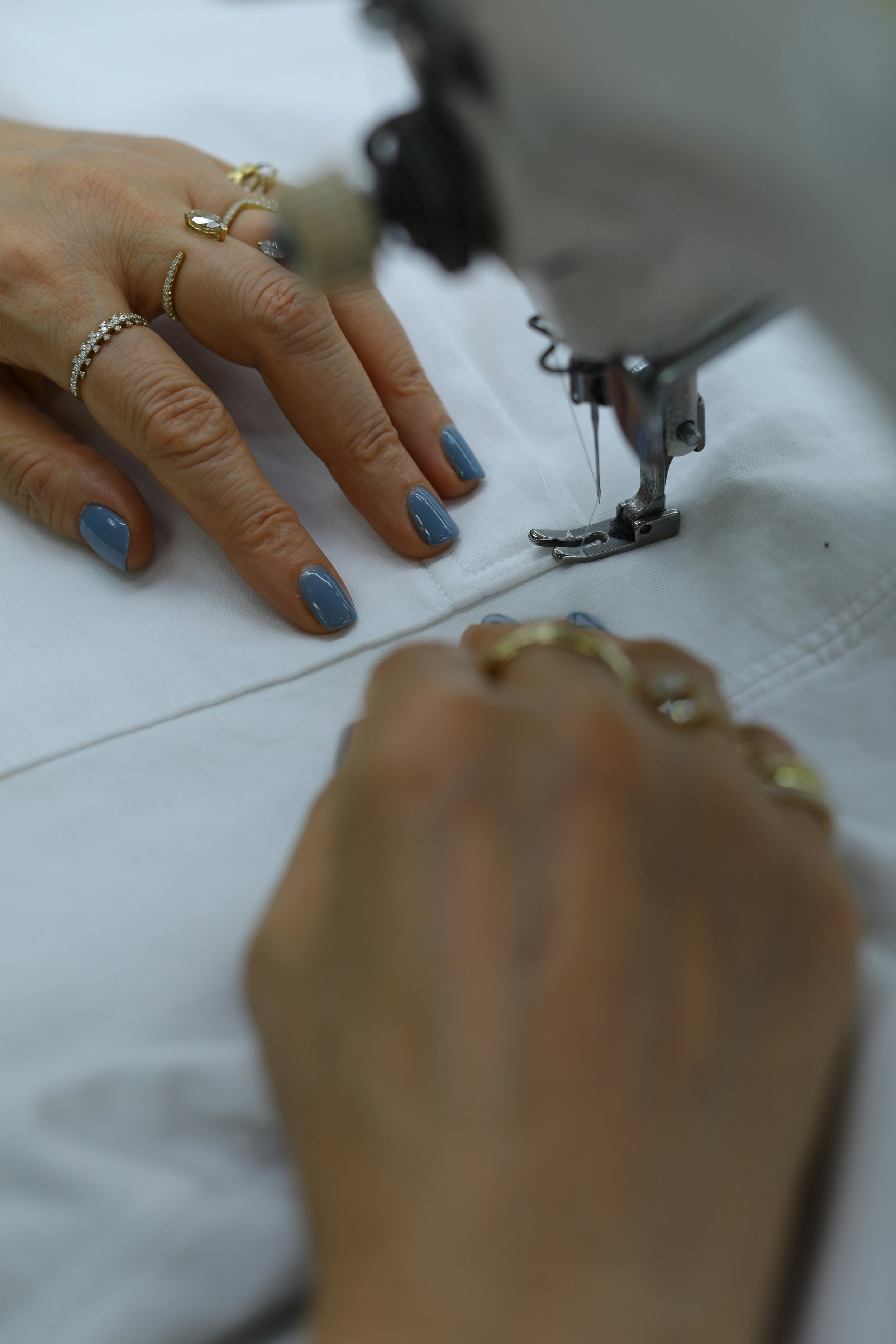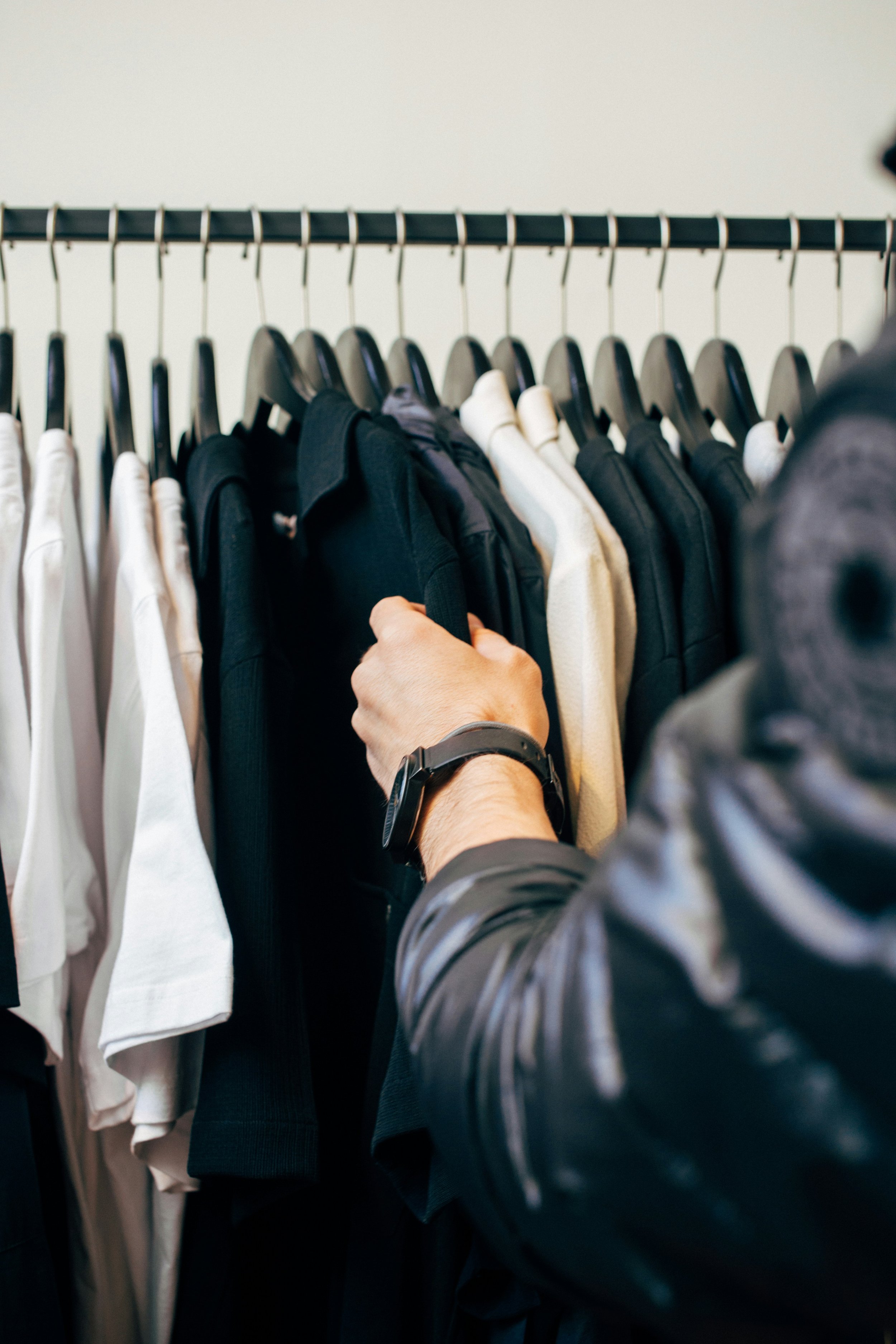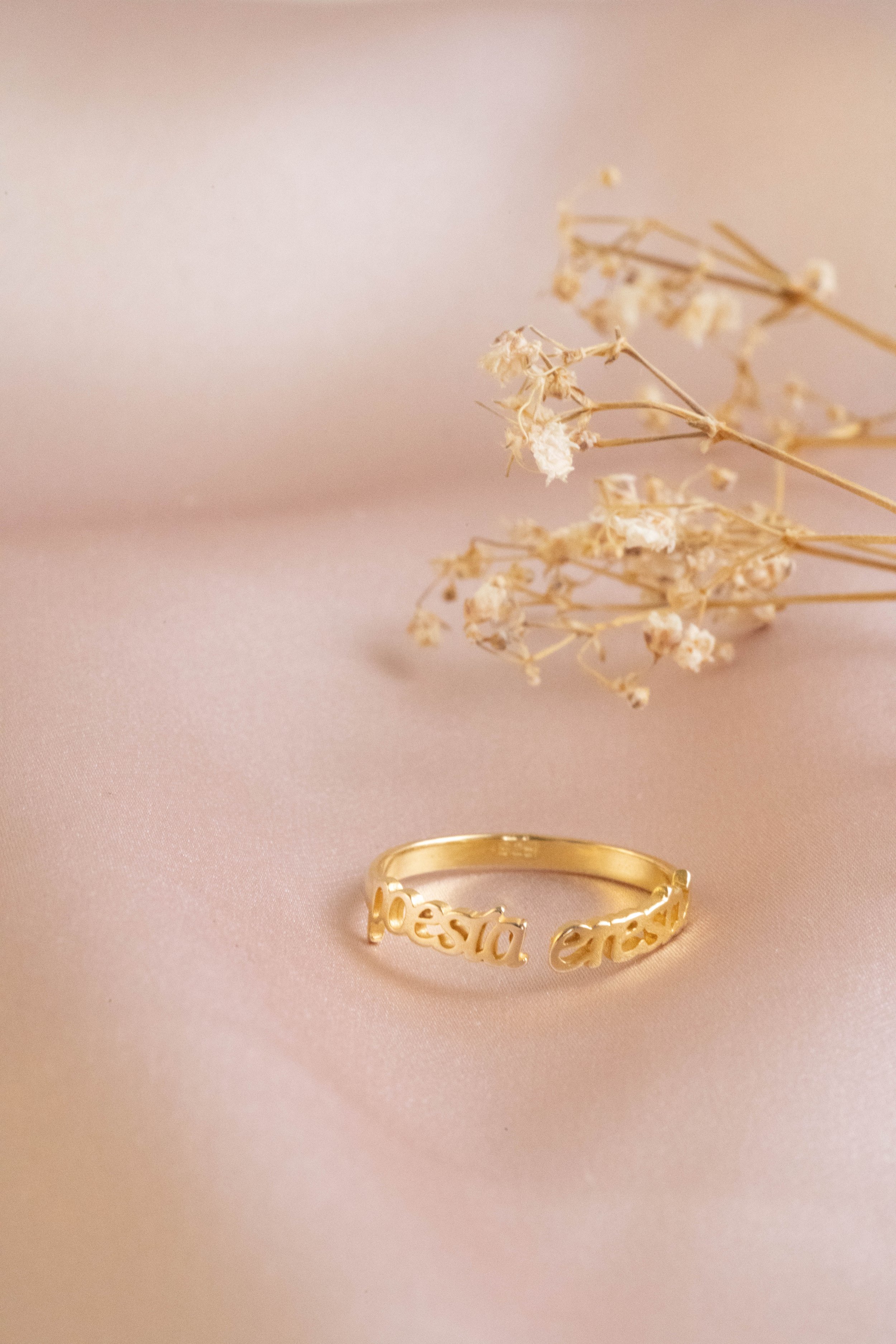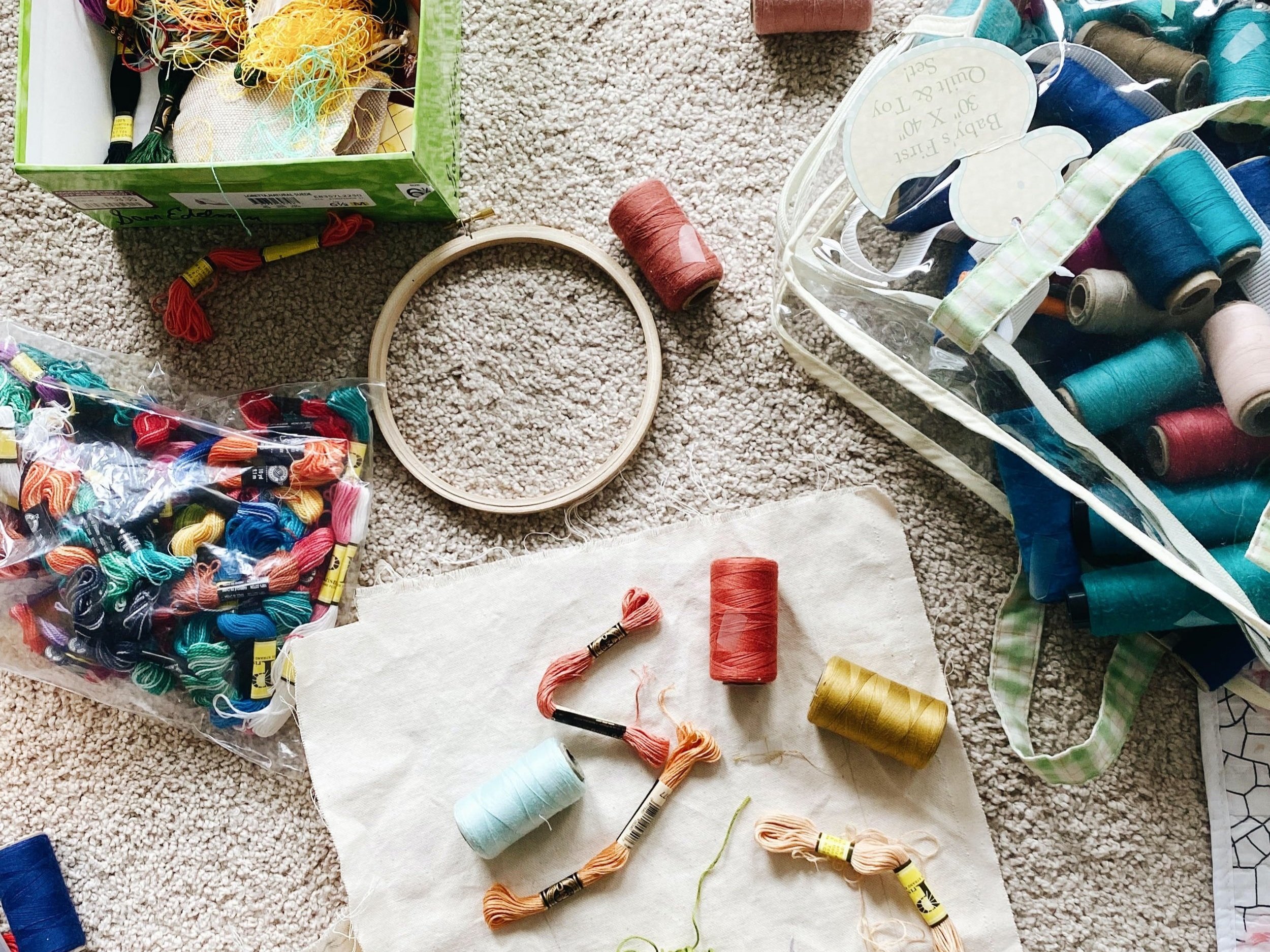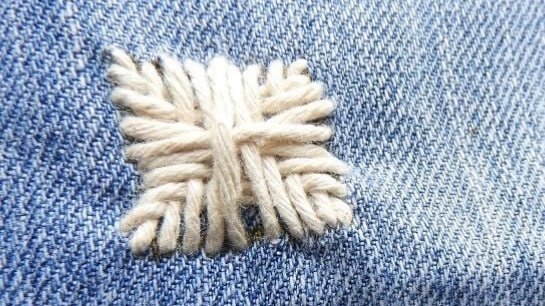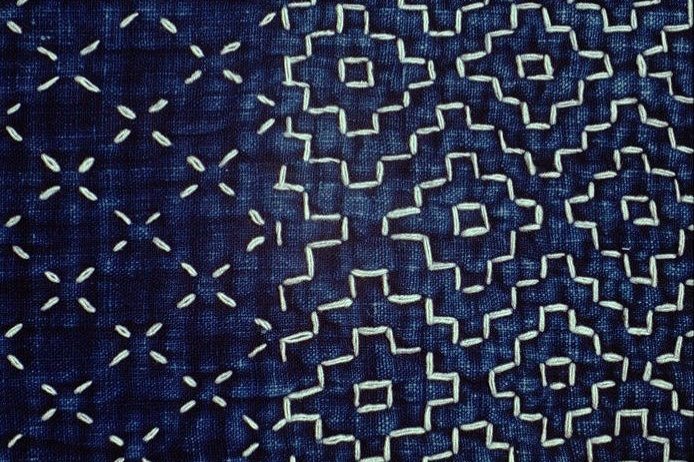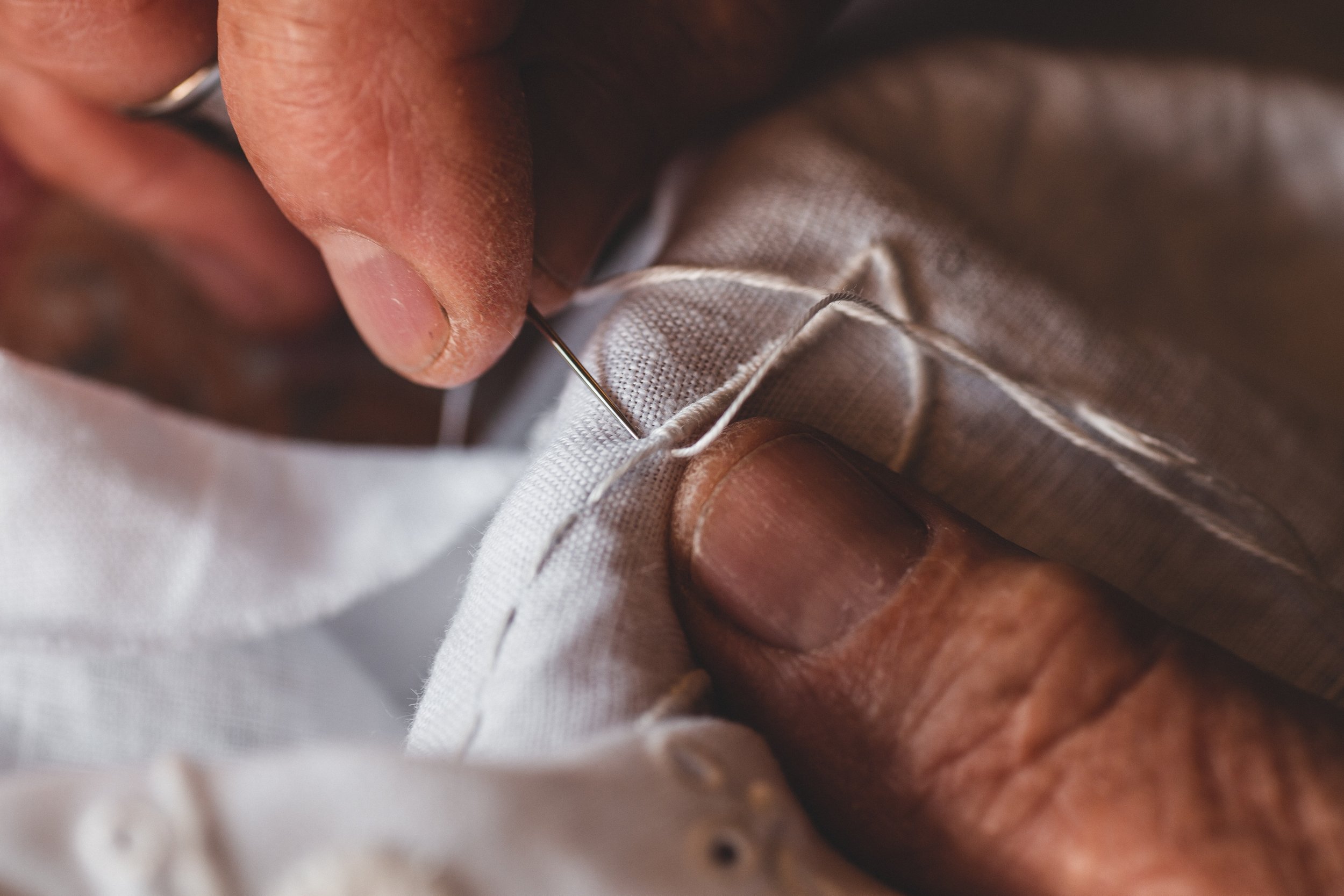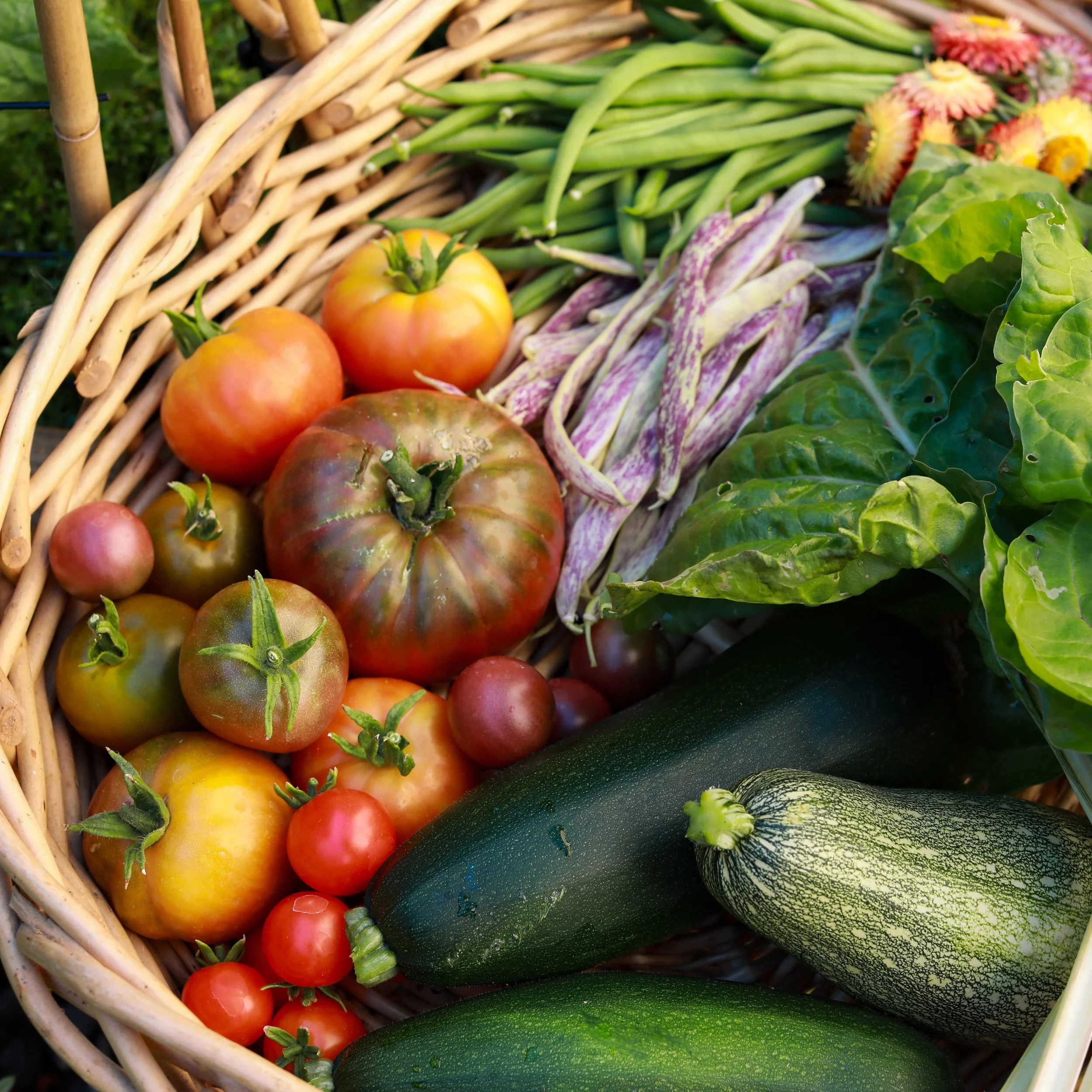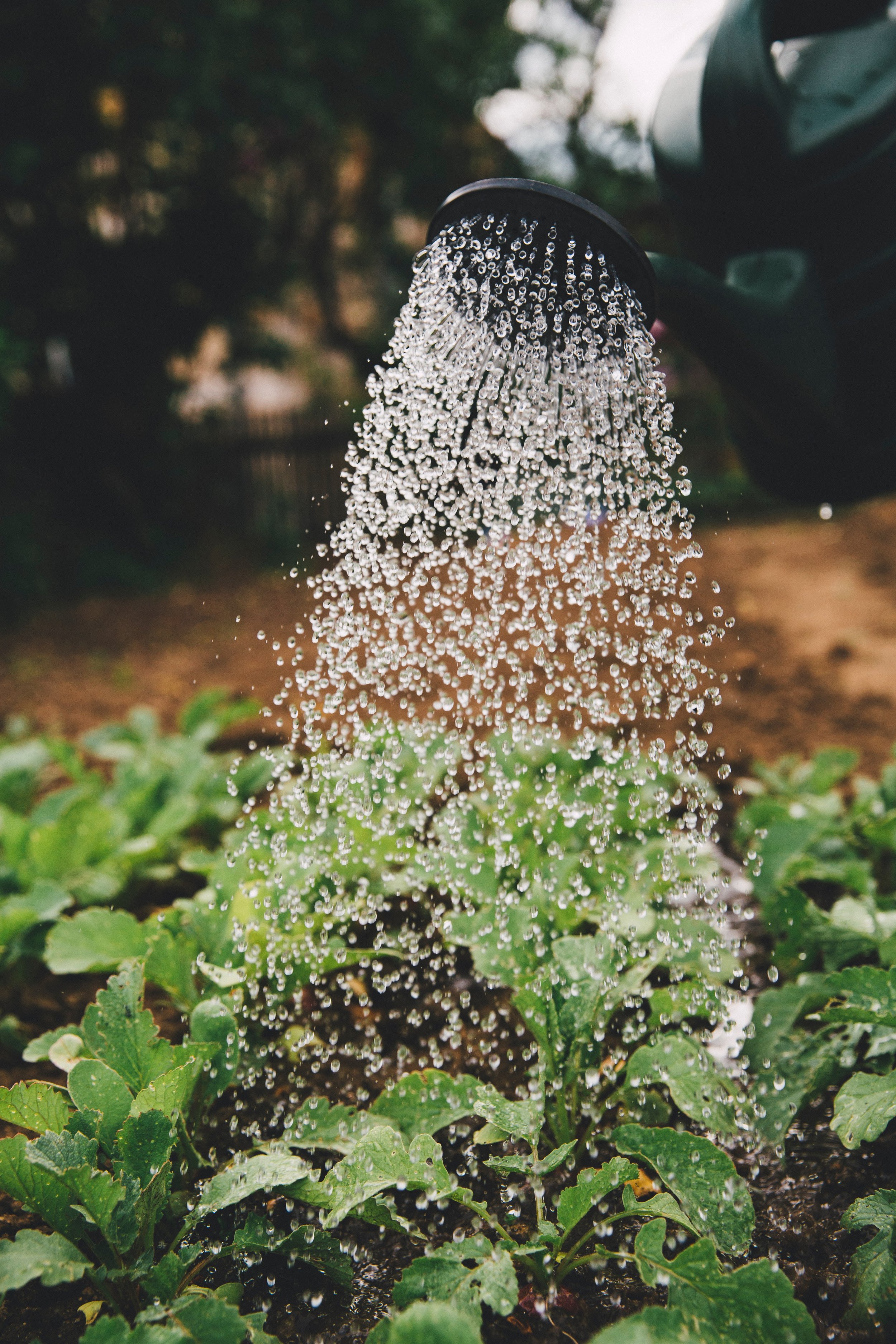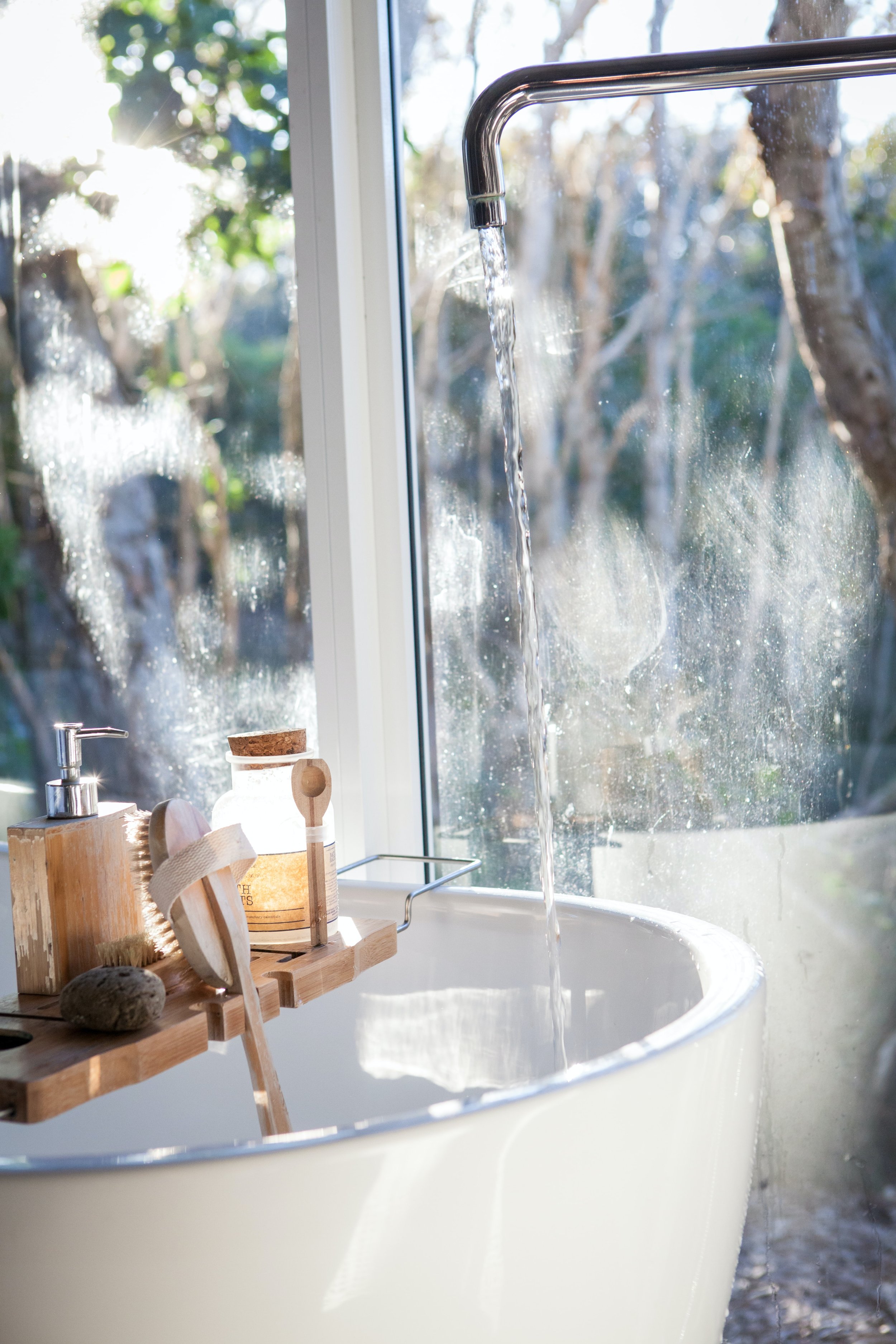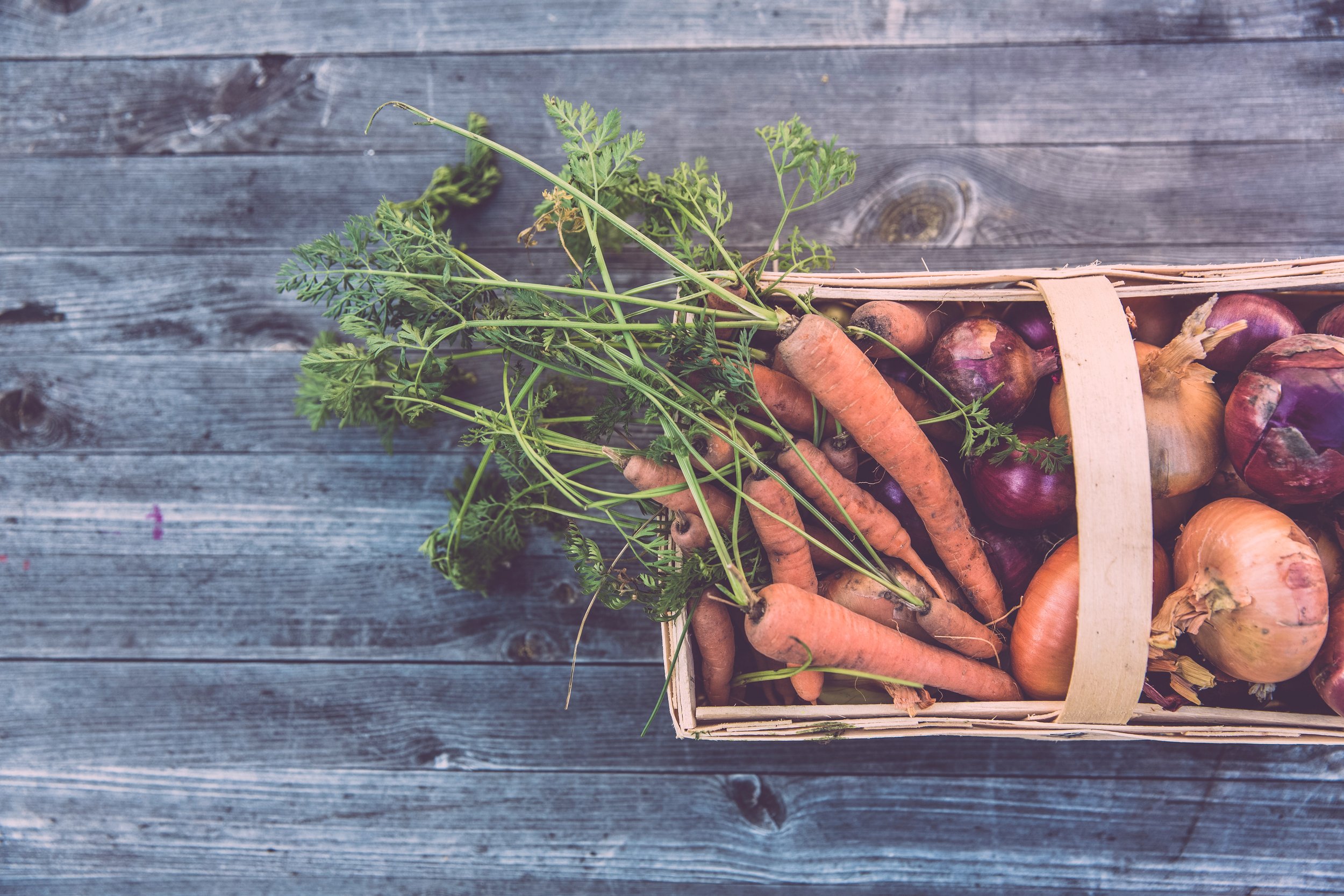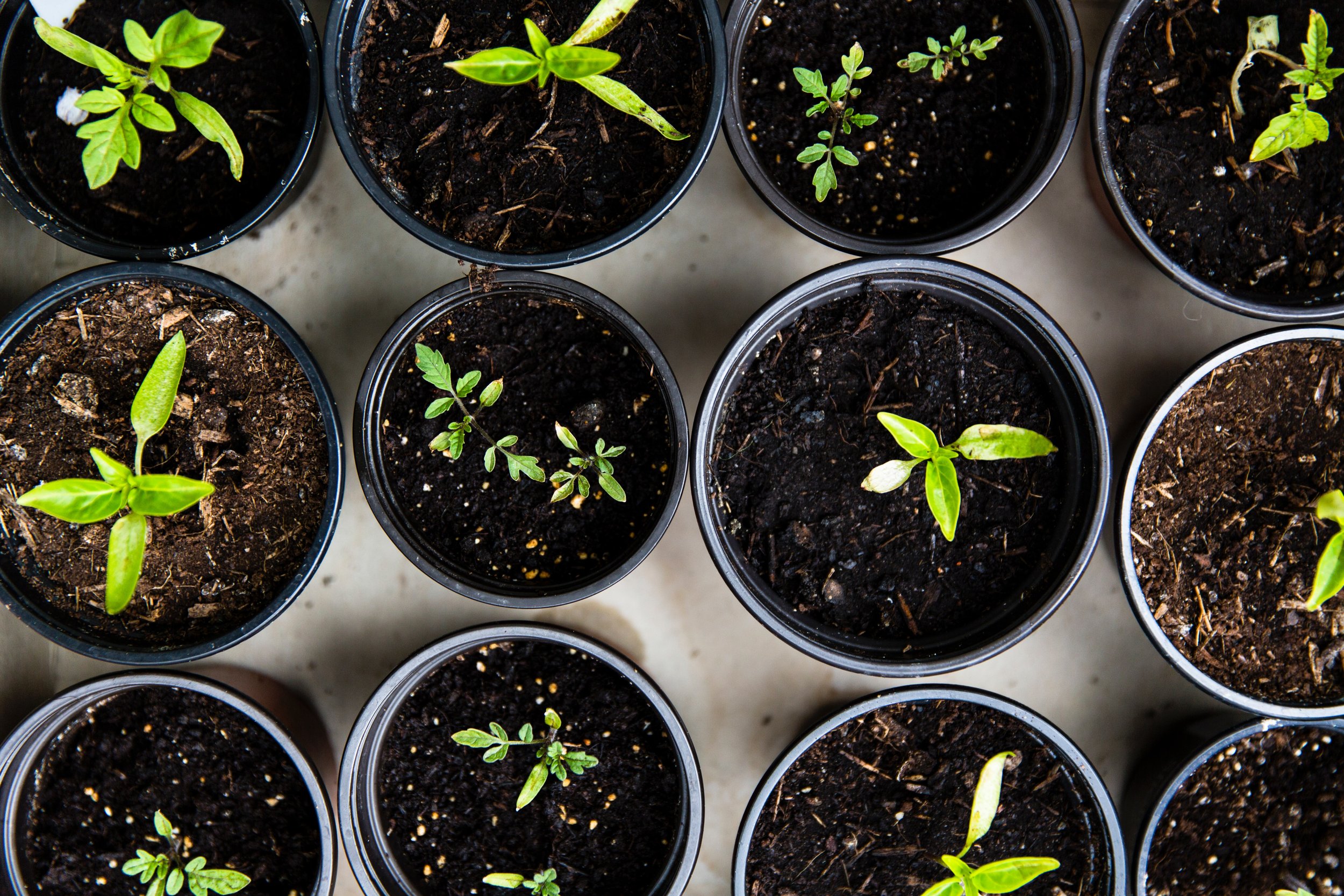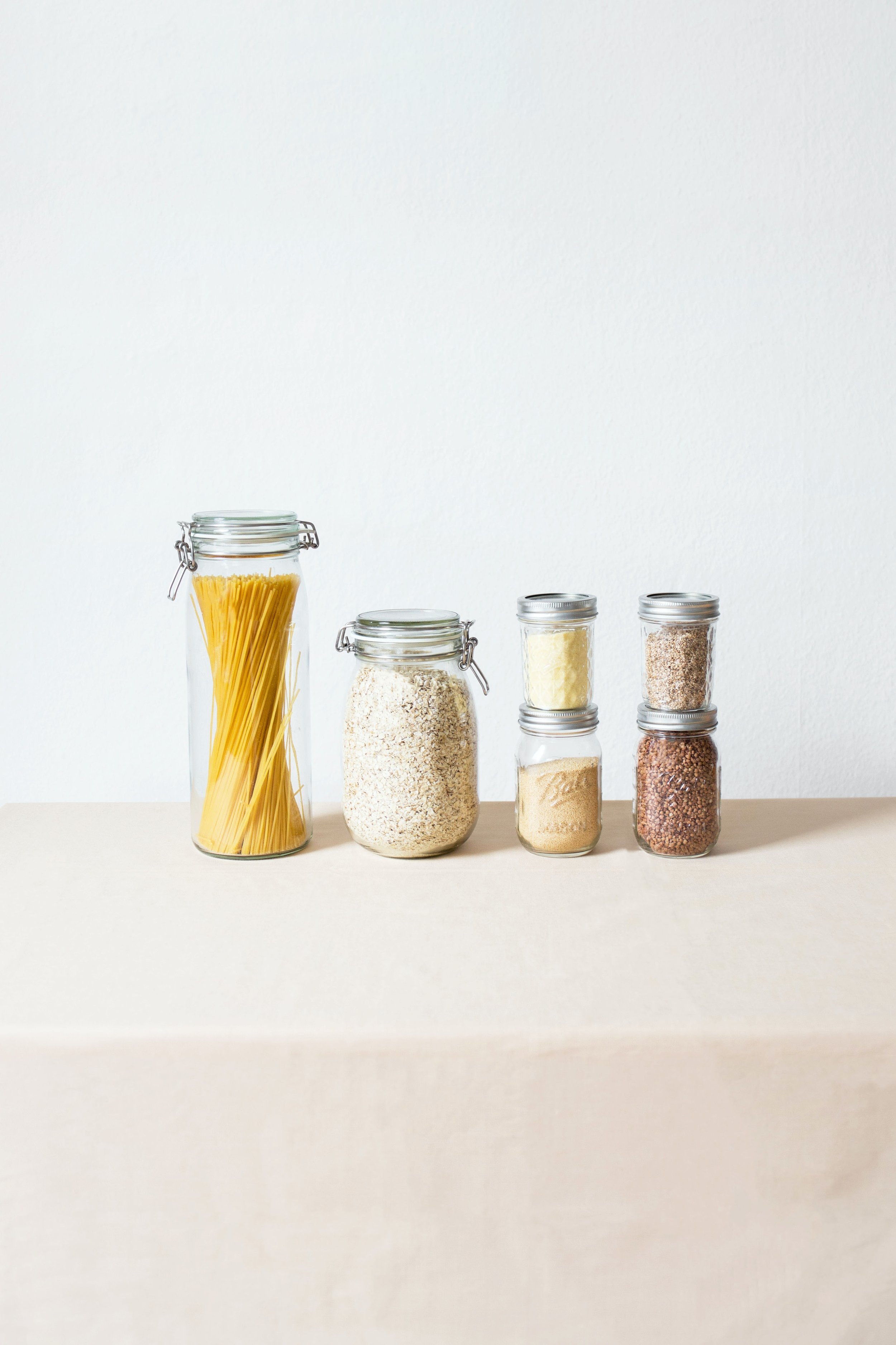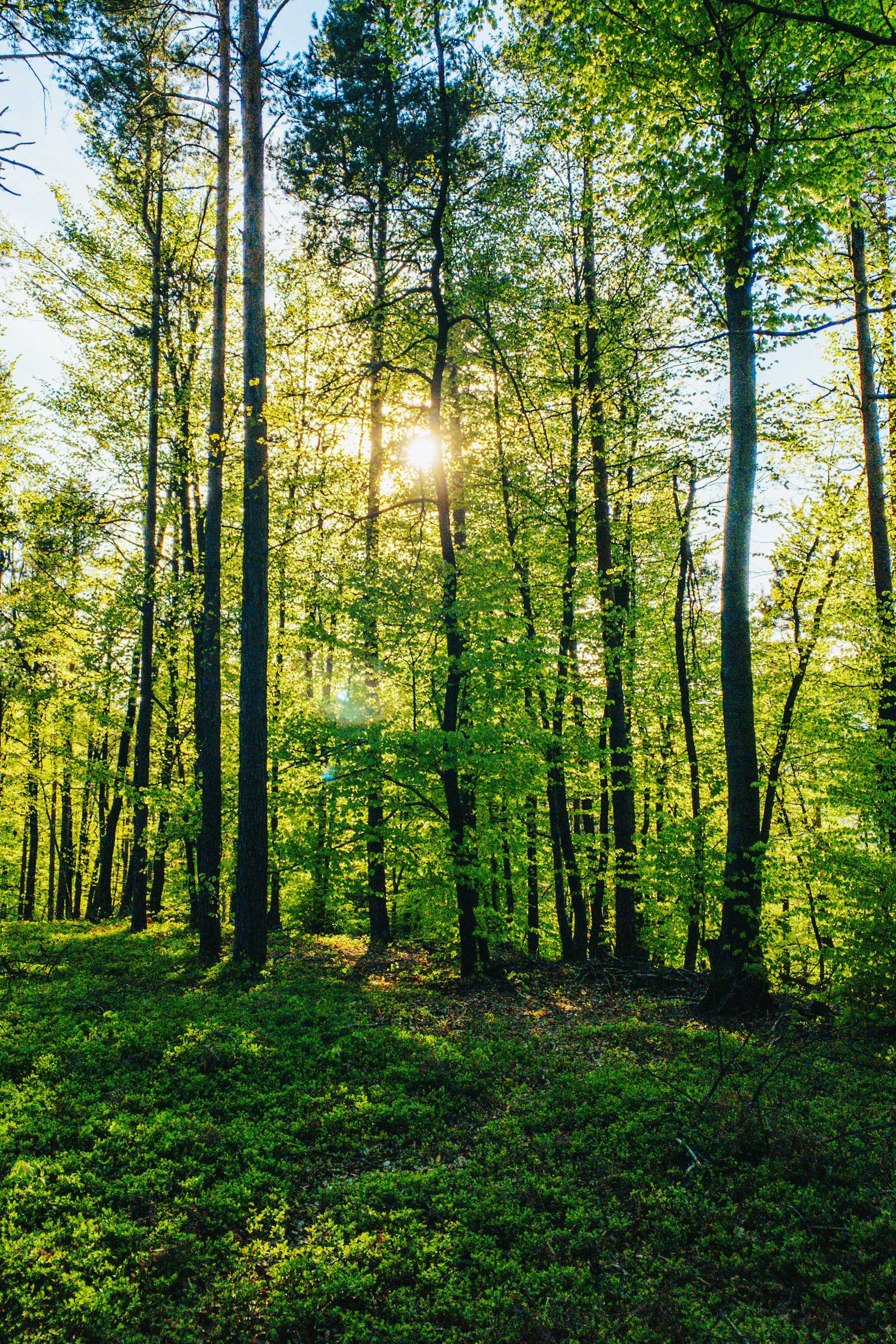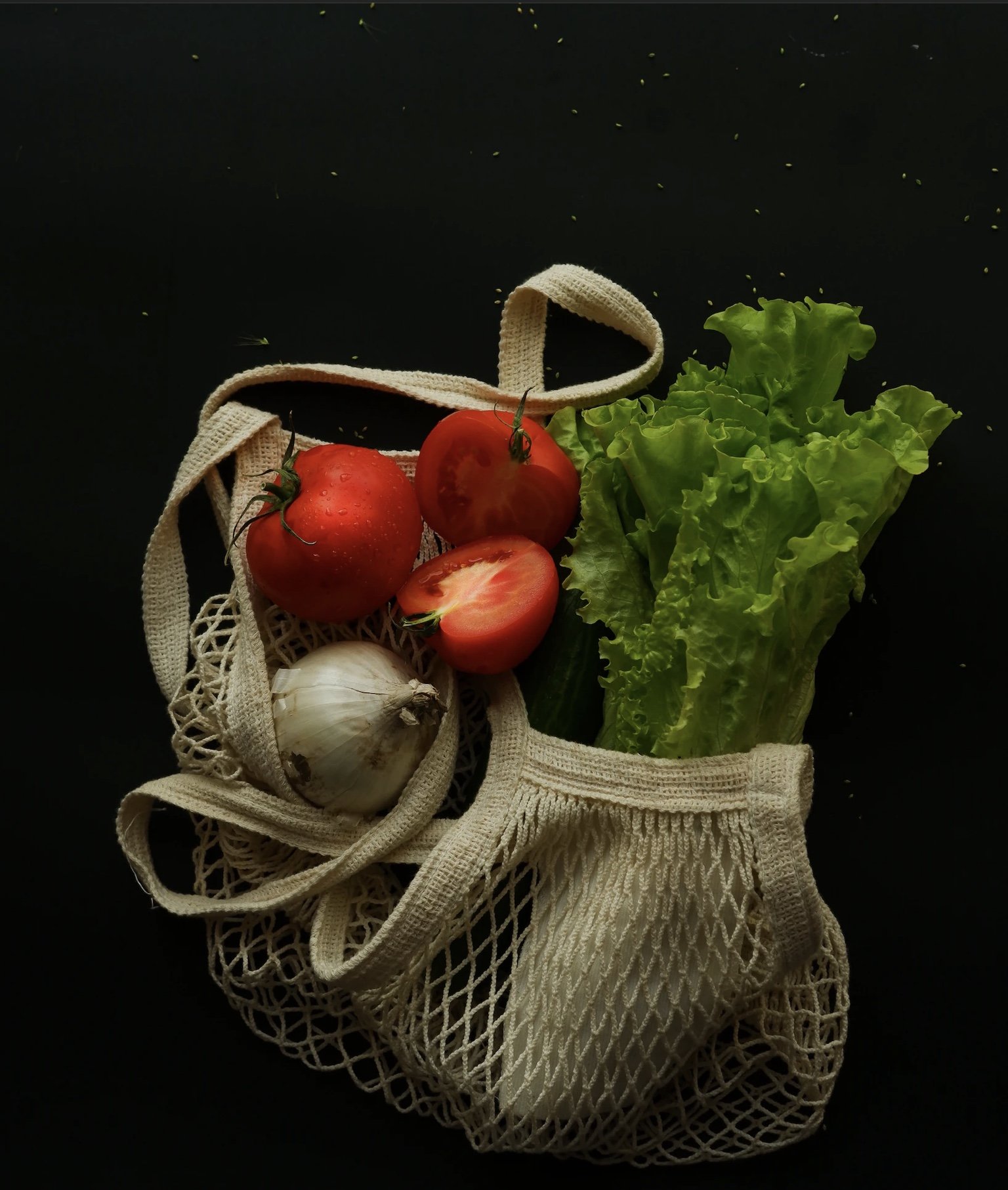How to Clothes Shop Sustainably on a Budget
Genuinely sustainable clothing can be expensive but a small clothing budget doesn’t mean that you can’t be planet-friendly.
Better still, shopping for low cost sustainable outfits can be a lot of fun. Our How to Guide shows you how.
Photo by Hong Nguyen on Unsplash
1. Buy nothing. The cheapest (and most extreme) approach! It might seem out of reach, but a quick social media search will soon locate others who are on the same path and have tips and encouragement to share.
Photo by Andrej Lišakov on Unsplash
◦ Check out what you have in your wardrobe and consider whether you really need anything else.
Photo by Priscilla Du Preez 🇨🇦 on Unsplash
◦ Where there are gaps, ask friends to raid their own wardrobes or wait until your birthday/ Christmas.
Photo by Niko Tsviliov on Unsplash
◦ If you need support, take a social media “buy nothing new” challenge.
Photo by Adithya Reza on Unsplash
2. Get the sales dates in your calendar. Many sustainable brands run sales and offers where you can pick up good deals on high quality clothing.
Photo by Maddi Bazzocco on Unsplash
◦ Try to plan your shopping in advance so that you can be sure to catch the sales early when you’ll have the best choice.
◦ Regularly check to see what needs replacing so that you can get a head of the game and avoid paying full price.
◦ January sales – from 1st, throughout January
◦ Spring clearance sales fall in late March to early May
◦ Easter sales start 2-3 weeks before Easter (mid-March 2026)
◦ Summer sales usually start in mid-June and peak around the beginning of July.
◦ Winter sales start on Black Friday (end of November) and then ramp up on Boxing Day
Photo by Arno Senoner on Unsplash
1. Make the most of Christmas and Birthdays. If you have the option, consider asking for higher price sustainable items like boots, shoes and coats, for your birthday or Christmas. People will often be thankful for gift ideas and you can ask for money from different people to make up the cost of a more expensive item.
Photo by Emily Pottiger on Unsplash
2. Shop Thrift/Charity Shops: It’s an obvious one but that’s because it’s such a good choice! Exploring local thrift stores and charity shops for second-hand clothing can lead you to unique pieces at a fraction of the original price while supporting charitable causes.
Photo by Adrienne Leonard on Unsplash
3. Online Resale Platforms: If you haven’t tried online platforms like Depop and Vinted, you are missing out! These peer to peer outlets are fantastic for picking up a bargain and for selling unwanted items. It feels good to save money and save clothing from land-fill
Photo by appshunter.io on Unsplash
4. Clothing Swaps: Organise or participate in clothing swap events with friends or community groups. It's a fun way to refresh your wardrobe without spending much money. Check out our blog on how to run a swap.
Photo by Toshi Kuji on Unsplash
5. Capsule Wardrobe: Another classic, the capsule wardrobe is your sustainable, minimalistic, reliable friend. Invest in a few high-quality, versatile pieces that can be mixed and matched. This approach reduces the need for frequent purchases and helps you create a sustainable wardrobe.
Photo by Priscilla Du Preez 🇨🇦 on Unsplash
6. DIY and Upcycling: Get creative by upcycling old clothes or making simple alterations to breathe new life into your wardrobe.
7. Renting Clothes: Consider renting outfits for special occasions instead of buying new ones. This is a sustainable option that allows you to wear something new without the commitment.
Photo by Klara Kulikova on Unsplash
8. Educate Yourself: Learn about sustainable fabrics and practices. This knowledge will help you make informed choices when shopping, even on a budget.
Photo by Maite Oñate on Unsplash
9. Prioritise Quality Over Quantity: It may take a bit more planning but focusing on buying fewer, high-quality items that will last longer is much cheaper in the long run.
Photo by Tanya Barrow on Unsplash
These tips can help you shop smarter and stick to your budget while being eco-friendly. We’d love to hear about your experiences!
How to Give your Old Clothes New Life
Give your old clothes new life as bags, home-wares, and accessories. Upcycling old clothes into new, useful items is not just an eco-friendly activity but also a fun and creative one. Not only does it reduce textile waste, but it also allows you to express your unique style and craftsmanship. There’s joy in upcycling. We will show you how to get started:
Assess Your Wardrobe:
Begin by sorting through your wardrobe for items that are no longer in use or are showing signs of wear and tear. Look for fabrics that are still in good condition and can be repurposed into new creations.
Photo by Adrienne Leonard on Unsplash
Choose Your Project:
Decide what you want to create from your old clothes. Bags, such as tote bags or pouches, are popular choices for upcycling projects. Alternatively, you could transform old t-shirts into throw pillows, denim jeans into coasters, or sweaters into cosy mittens. These are just a few ideas. We’ve found some fabulous projects: check out the links below.
Photo by Giorgio Trovato on Unsplash
Gather Your Materials:
Once you've chosen your project, gather any additional materials you might need, such as sewing supplies, zippers, buttons, or embellishments. Consider mixing and matching different fabrics and textures to add visual interest to your creations.
Photo by pina messina on Unsplash
Get Creative:
Let your imagination run wild as you breathe new life into old garments. Cut, sew, and embellish your pieces to create unique and functional items that reflect your personal style. Experiment with different patterns and techniques to achieve the desired look.
Embrace Imperfections:
Remember that upcycling is about embracing imperfections and giving new purpose to old materials. Don't be discouraged by mistakes or uneven stitches; they add character to your handmade creations.
Photo by lucas mendes on Unsplash
Share Your Creations:
Once you've completed your upcycling projects, proudly showcase your creations to friends, family, and the online community. Not only will you inspire others to embrace sustainable practices, but you'll also gain satisfaction from knowing that you've contributed to reducing textile waste.
Photo by Sasha Matveeva on Unsplash
Upcycling old clothes into bags, homewares, and accessories is not only a creative way to breathe new life into forgotten garments but also a meaningful step towards a more sustainable future. So, roll up your sleeves, unleash your creativity, and let the transformation begin!
Photo by DESIGNECOLOGIST on Unsplash
Projects
Upcycling jeans: For some gorgeous ideas for giving jeans a new life, check out 74 AWESOME ideas to recycle jeans | My desired home
Not quite clothing, but old blankets can provide wonderful material for beautiful home and clothing projects. Familyhandyman.com has a variety of ideas from an adorable fox hot water bottle cover to a guitar case!
https://www.familyhandyman.com/list/ways-to-repurpose-an-old-wool-blanket/
With their fun colours and patterns, baby clothes are perfect for transforming in to super cute home décor.
https://diycandy.com/upcycled-clothing-ideas/ has a lovely idea for a baby clothes throw pillow as well as a sweater-upholstered stool and a lumberjack shirt throw. For something really fun, check out their faux cacti made from old socks!
How to Stand up to Fast Fashion
Fast Fashion is associated with vast amounts of waste, damage to the environment, sweatshop labour, and harm to communities.
Photo by Rio Lecatompessy on Unsplash
There are lots of ways to stand up to Fast Fashion, and we’ve mentioned many of these in previous blogs. If you’ve made the decision to shop sustainably and ethically, mend clothes, reuse and recycle and want to step up your sustainable fashion game, Fashion Revolution is a great organisation to get involved with.
Photo by Alireza Dolati on Unsplash
Fashion Revolution is the world’s largest fashion activism movement, mobilising citizens, brands and policymakers through research, education and advocacy. This year, they are celebrating 10 years of activism with 10 days of action, beginning on 15th April.
Photo by Francois Le Nguyen on Unsplash
Here’s our guide to joining in.
First, here's some more about Fashion Revolutionindustry
• Fashion Revolution is a global movement and non-profit organisation that advocates for a more transparent, ethical, and sustainable fashion industry
• It was founded in the aftermath of the Rana Plaza building collapse in Bangladesh in 2013, which tragically killed over 1,100 garment workers.
• It aims to raise awareness about the social and environmental impacts of the fashion industry and campaigns for transparency and accountability throughout the supply chain.
Photo by Francois Le Nguyen on Unsplash
• Fashion Revolution publishes the results of its survey of transparency and accountability in fashion brands’ supply chains.
Photo by Hermes Rivera on Unsplash
• Learn more here:
https://www.fashionrevolution.org/about/
To stay updated on Fashion Revolution activities and campaigns, follow them on the socials and sign up for their newsletter.
Photo by Solen Feyissa on Unsplash
Insta: @fash_rev
Check out this page for all of their other handles and to get the newsletter
Join the Fashion Revolution Week Campaign:
• Print a “Who Made my Clothes?” poster and take a selfie to post on your social media. Tag brands you want to challenge about fast fashion.
• Find your country team (if you’re not in UK, you can join with a local team).
Photo by Good Faces on Unsplash
• Learn a new skill to help you be a Fashion Revolutionary. Between 16th and 23rd April, there are free online workshops on being a Storyteller, a Campaigner, a Community Builder and and Educator. Sign up here: https://www.fashionrevolution.org/frw-24-workshops/
• Take part in a Mend in Public Day to raise awareness of how to “Make Loved Clothes Last”.
Photo by Clément Vatte on Unsplash
• Host your own Fashion Revolution event: organize a clothing swap, a screening of a documentary about the fashion industry, a panel discussion with local experts, or a workshop on sustainable fashion practices.
• Donate to the work of Fashion Revolution
Find out more here: https://www.fashionrevolution.org/about/get-involved/
How to ask Brands #WhoMadeMyClothes?:
• Asking brands this question helps to send the message that we care about the human beings involved in fashion production, not just low prices and latest looks.
Photo by Lucrezia Carnelos on Unsplash
• Print a “Who Made my Clothes?” poster and take a selfie with it. Post your selfie on social media and tag fashion brands to encourage them to disclose information about their sourcing, production, and labour conditions.
• You might want to target brands that currently disclose less of their supply chain information, or brands whose clothes you buy. Here are the Transparency Index scores for a few well-know brands (the higher the better):
Gucci 80%
H&M 71%
Timberland 66%
Sainsburys 51%
Zara 50.%
Primark 40%
Marks and Spencer 38%
Boohoo 24%
Clarks 17%
Chanel 11%
Find out more here: https://www.fashionrevolution.org/about/transparency/
Educate Others
fashionrevolution.org has loads of great resources to share on social media and with your friends and family. You can find them on their website
Photo by charlesdeluvio on Unsplash
Stay Engaged Year-Round
While Fashion Revolution Week is a focal point for the movement, continue to stay engaged with the issues and advocate for change throughout the year. Support initiatives that promote transparency, ethical fashion, and sustainable practices in the fashion industry.
Photo by Oladimeji Odunsi on Unsplash
By taking part in Fashion Revolution 2024, you can contribute to the collective effort to create a more transparent, ethical, and sustainable fashion industry. Every action, no matter how small, helps to drive positive change and hold brands accountable for their impact on people and the planet.
Photo by Markus Spiske on Unsplash
How to Choose Good Gifts
Christmas is a time for joy, generosity, and giving. However, it's also a time when consumerism is at its peak, leading to increased waste and environmental issues. This year, why not make a conscious effort to choose sustainable gifts that not only bring joy to your loved ones but also have a positive impact on the planet?
Photo by Chang Duong on Unsplash
In this blog, we'll guide you on how to select great sustainable Christmas gifts that align with your values and help make the season truly meaningful.
Photo by Nathan Dumlao on Unsplash
Start with Purpose
Before embarking on your sustainable gift-giving journey, reflect on your purpose. Ask yourself why you want to give a gift. Is it to show love and appreciation, promote a specific cause, or simply spread joy? Understanding your motivation will help you make more conscious choices.
Photo by Kolby Milton on Unsplash
Consider Experiences
Gifts don't always have to be physical objects. Consider gifting experiences like cinema tickets, cooking classes, creative workshops or spa vouchers. You can even create vouchers for DIY experiences like home-made afternoon tea or for favours like baby-sitting. Experiences create memories that can last a lifetime, and they often have a lower environmental impact than material possessions.
Buy Local
Support local businesses and artisans by purchasing gifts that are made in your community. Local products often have a smaller carbon footprint as they require less transportation. Plus, you'll be contributing to the livelihood of your neighbours and promoting sustainable economic growth.
Photo by Dmitry Mashkin on Unsplash
Upcycled and Recycled Gifts
Look for gifts that have been created from upcycled or recycled materials. These items not only reduce waste but also encourage creativity and innovation. Common upcycled gifts include jewellery made from repurposed materials, handbags from old sails, or furniture made from reclaimed wood.
Photo by Edwin Chen on Unsplash
Sustainable Fashion
If you're considering clothing or accessories, choose sustainable fashion brands that prioritise ethical and eco-friendly production methods. Look for items made from organic, renewable, and biodegradable materials. High-quality sustainable fashion pieces are not only stylish but also long-lasting.
Photo by Anna Sullivan on Unsplash
Thoughtful Personalisation
Personalised gifts show that you've put thought and care into your choice. Rather than generic mass-produced items, opt for something unique and tailored to the recipient's interests and personality. Handmade or customised gifts often have more sentimental value.
Eco-Friendly Wrapping
Don't forget about the wrapping! Avoid traditional wrapping paper, which is often not recyclable, and opt for sustainable alternatives. You can use recycled or upcycled paper, cloth gift bags, or even wrap gifts in scarves or reusable shopping bags.
Photo by Nina Mercado on Unsplash
Charitable Gifts
Consider giving gifts that support a charitable cause or organisation. Donations to a charity, the purchase of a 'gift of giving,' or items where a portion of the proceeds goes to a specific cause can make a positive impact beyond the recipient.
Eco-conscious Electronics
If you're considering tech gifts, look for energy-efficient and eco-friendly electronics. Many companies now offer electronic gadgets and accessories made from sustainable materials and designed to consume less power.
Photo by Nicholas Doherty on Unsplash
Get creative and make your gifts. Handmade gifts, whether it's homemade jam, a knitted scarf, or a piece of artwork, have a personal touch. Pinterest is a brilliant place to look for ideas and tutorials.
Photo by Stephanie Harvey on Unsplash
Choosing good sustainable Christmas gifts is not just a way to reduce your environmental impact; it's also an opportunity to connect with loved ones on a deeper level and make the season more meaningful. By thinking consciously about your gift choices, you can demonstrate your love and appreciation while contributing to a more sustainable future. This Christmas, let's make the world a better place, one eco-friendly gift at a time.
How to Support Circular Fashion
Fashion has always been synonymous with change, but the tide is turning. As the environmental and social costs of the fast fashion industry become increasingly apparent, many of us are seeking a more sustainable and responsible approach to dressing.
Photo by Ayo Ogunseinde on Unsplash
Enter circular fashion – a movement that promotes longevity, sustainability, and ethical production in the world of clothing. In this blog post, we'll explore what circular fashion is and how you can support it as a conscientious consumer.
Understanding Circular Fashion Circular fashion is a philosophy that aims to create a closed-loop system in the fashion industry. Unlike the traditional linear model (take, make, dispose), the circular fashion approach prioritises the following principles:
Design for Durability: Circular fashion starts with designing and producing garments that are made to last. Quality materials, craftsmanship, and timeless designs are key components of this principle.
Repair and Maintenance: Rather than throwing away clothes with minor flaws, circular fashion encourages repair and maintenance. This involves sewing, mending, and alterations to extend the life of your garments.
Photo by Victoria Nazaruk on Unsplash
Reuse and Upcycling: Circular fashion promotes the reuse of clothing through thrift shopping, swapping with friends, or participating in clothing rental services. Upcycling, or transforming old pieces into something new, is also part of the equation.
Photo by Mediamodifier on Unsplash
Recycling and Responsible Disposal: When a garment is no longer wearable, circular fashion encourages responsible disposal through recycling and repurposing. This minimises the environmental impact of textile waste.
Photo by 🇸🇮 Janko Ferlič on Unsplash
Educate Yourself: The first step in supporting circular fashion is to educate yourself about sustainable and ethical brands, materials, and practices. Look for certifications like Fair Trade, GOTS (Global Organic Textile Standard), and OEKO-TEX to ensure the products you buy meet ethical and environmental standards.
Photo by Ethan Bodnar on Unsplash
Choose Quality Over Quantity: Invest in high-quality, timeless pieces that will last for years rather than trendy, disposable fashion. Quality garments often have a higher upfront cost, but they pay off in terms of longevity and reduced environmental impact.
Photo by Priscilla Du Preez 🇨🇦 on Unsplash
Second-Hand Shopping: Thrift stores, vintage shops, and online second-hand marketplaces offer a wide range of clothing options. Buying second-hand not only extends the life of garments but also reduces the demand for new production.
Photo by Onur Bahçıvancılar on Unsplash
Rent or Swap: Consider clothing rental services or clothing swap events with friends and family. These options allow you to enjoy a variety of styles without the long-term commitment.
Photo by charlesdeluvio on Unsplash
Support Sustainable Brands: Seek out and support fashion brands that prioritise sustainability, transparency, and ethical production practices. Research the brands you love to ensure they align with your values.
Photo by Hong Nguyen on Unsplash
Learn Basic Repair Skills: Basic sewing skills can go a long way in extending the life of your clothing. Learn how to mend small tears, replace buttons, and alter garments to fit better.
Photo by ROCCO STOPPOLONI on Unsplash
Proper Care: Follow care instructions on clothing labels to ensure your garments stay in good condition. Washing clothes at lower temperatures and air-drying them can help prolong their lifespan.
Photo by Elisa Calvet B. on Unsplash
Recycle Responsibly: When a garment reaches the end of its life, don't toss it in the trash. Look for textile recycling programs in your area or explore creative ways to repurpose old clothing.
Photo by Joshua Lawrence on Unsplash
Supporting circular fashion as a consumer is a powerful way to contribute to a more sustainable and responsible fashion industry. By choosing quality, embracing second-hand options, and supporting brands that prioritise ethical and environmental concerns, you can make a positive impact on the planet while still expressing your personal style. Remember that every small choice you make as a consumer has the potential to shape the future of fashion in a more sustainable direction.
Photo by Junior REIS on Unsplash
How to Upcycle Clothing
Whether you are a seasoned designer, a thrifty fashion enthusiast, or someone looking to make a positive impact on the planet, upcycling clothing offers a world of possibilities.
It empowers us to reimagine the potential of our wardrobes, inspiring us to embrace creativity, sustainability, and a more conscious approach to fashion.
Photo by Utopia By Cho on Unsplash
Our ‘how to’ guide to upcycling helps you dive into the world of upcycling and unlock the hidden treasures in your closet, one stitch at a time.
1. Assess your wardrobe: Start by going through your wardrobe and identifying clothing items that you no longer wear or that are damaged. Look for garments made from materials that can be easily repurposed, such as cotton, denim, or wool.
Photo by Olena Sergienko on Unsplash
2. Gather supplies: Before you begin upcycling, gather the necessary supplies. These may include sewing tools like scissors, needles, thread, and a sewing machine. Additionally, consider collecting buttons, ribbons, lace, and other decorative elements to enhance your upcycled creations.
Photo by Casey Chae on Unsplash
3. Brainstorm ideas: Let your creativity flow and brainstorm different ways to upcycle your clothing. Think about how you can transform a shirt into a trendy crop top or turn jeans into shorts. Research upcycling projects online or look for inspiration on social media platforms like Pinterest or Instagram.
Photo by Kelly Sikkema on Unsplash
4. Repair and mend: If you have garments with minor damage, like small tears or missing buttons, repair them before proceeding with upcycling. Simple fixes can extend the life of the clothing and make them suitable for upcycling projects.
Photo by Toa Heftiba on Unsplash
5. Plan your project: Before cutting or altering any garments, create a plan. Use a sketchbook or paper to sketch out your ideas, note measurements, and visualize how the final product will look. This will help you stay organized and ensure your upcycling project turns out as intended.
Photo by Maria Lupan on Unsplash
6. Get cutting and sewing: Once you have a plan, start cutting and sewing your clothing. Use your scissors to remove unwanted parts or to modify the shape of a garment. Consider adding patches or fabric inserts to give new life to old clothes. Get creative with different stitching techniques to add unique details.
7. Add embellishments: Enhance your upcycled creations by adding decorative elements. Sew on buttons, beads, ribbons, or appliques to transform a plain piece into a statement item. This is your opportunity to add personal touches and make your upcycled clothing truly unique.
Photo by Ratih Mandalawangi on Unsplash
8. Experiment and learn: Upcycling is a chance to experiment and learn new skills. Don't be afraid to try different techniques or combine various fabrics and textures. If something doesn't turn out as expected, view it as a learning experience and adjust your approach for future projects.
Photo by Nathana Rebouças on Unsplash
9. Share and inspire: Once you've successfully upcycled your clothing, share your creations with others. Post pictures on social media, participate in local fashion shows, or organize a clothing swap event to inspire others to upcycle their textiles too. Encourage sustainable fashion practices and promote the idea of reducing waste.
Photo by Anton van der Weijst on Unsplash
Remember, upcycling clothing and textiles not only helps reduce environmental impact but also allows you to express your creativity and create unique pieces that reflect your personal style. Enjoy the process and have fun with your upcycling projects!
How to Mend Clothing
Mending clothing is a great sustainable option. It extends the lifetime of the item and saves you money.
You need to learn a couple of basic hand sewing techniques and grab a couple of sewing tools like needle and thread to get started.
The best thing about mending clothing instead of throwing the item out is that you are repairing and reusing it and saving the clothing from going to landfill.
Types of Mending
Fixing holes or tears
To fix holes and tears, attach fabric behind the hole to strengthen the item. You can use a special fabric called interfacing for a subtle mend or you can make the mend a feature by using a scrap of contrasting fabric underneath the tear.
Read more about what stitches and techniques to use here:
How to repair stains
Removing a stain is another way to revive your garments and save them from landfill.
Firstly act quickly so it’s easier to remove.
1. For a large stain soak the stained item in a solution of 50% vinegar and 50% water
2. Rinse the item in cold water
3. Wash the item in cold water with laundry liquid and water
4. Don’t dry the item until the stain has fully come out.
For a small stain use a mix of vinegar, washing up liquid or lemon with water
Gently rub on the stain until removed
Rinse with cold water before putting it in the wash
Baking soda can also lift tough stains from garments
Make a paste with six tablespoons of baking soda and 1/3 cup of warm water
Rub it in the stain and leave it until the stain has lifted
Wash as normal
Try these methods and your item will be like brand new. It’s you wanted to be creative you could paint a design over the stained area with fabric dye or iron on designs.
Need advice on specific stains check out this link for eco friendly stain removal:
https://www.savemoneycutcarbon.com/learn-save/how-to-remove-stains-in-an-eco-friendly-way/
Visible mending
This is a fun and practical idea. Rather then fixing clothing so you can’t see the damage, visible mending makes a point of showing that the item was damaged and repaired.
Check out more viable mending on this link:
https://blog.shopmartingale.com/quilting-sewing/mending-is-trending-give-new-life-to-old-favorites-with-visible-mending/
It’s an opportunity to get creative and add something unique to the item. Why not try stitching with a contrast colour to make the item pop.
You can also add embroidery designs onto the garment by fixing an embroidery hoop around the damaged area and stitching your design on-top.
Patchwork
Make clothing more stylish and unique by adding your own stamp to the item. Try stitching on coloured or patterned patches or different fabrics to add texture. Go for a random pattern or create a design. You can buy already designed patches to sew on.
Japanese techniques
Wabi Sabi
‘’A Japanese aesthetic concept that finds beauty and serenity in objects, landscapes, designs, etc that are simple, Imperfect and impermanent; it’s the philosophy of wabi-sabi, which delights in the tarnish on an ancient silver bowl and the old uneven cobblestone.’ Dictionary.com
Boro Stitch
‘Boro is essentially the practice of using a simple running stitch (a sashiko stitch ) to reinforce a textile item using spare or would-be-discarded scraps of fabric. It is a practice that grew out of necessity in medieval Japan, and has evolved, four centuries later, into a distinctively gorgeous textile artform’
https://indigoniche.com/2018/08/30/boro-stitching-introduction-history/
Sashisko
‘Sashiko is a form of decorative reinforcement stitching (or functional embroidery) from Japan. Traditional sashiko was used to reinforce points of wear or to repair worn places or tears with patches.’
https://craftatlas.co/crafts/sashiko
These all embody a more historical circular movement using these techniques today can help the fashion industry move away from waste - fashion been turned into landfill.
History
Make do and mend
From June 1941 - 1949 buying new clothing in Britain was rationed. Make do and mend was born as part of a government campaign urging people in the Second World War to repair and reuse their existing clothing.
Here some make do and mend top 10 tips:
https://www.iwm.org.uk/history/10-top-tips-for-winning-at-make-do-and-mend
Getting Started
First ask yourself whether the item is worth repairing. Do you still like it? Is the rest of the item in good condition? Is it an heirloom? Is it worth the time and effort to repair ? If the answer is yes, then carry on!
Choose what mending techniques to use
Here are a few tips to help you decide which techniques to use for your mend
What effect do you want?
Do you want an invisible repair or to make a feature of it? For smart or work clothing you may want to go for less obvious repairs. For casual clothes, you might want to get creative.
What Type of fabric are you repairing
Wool – darning technique
Woven fabric – patches/ interfacing/ reinforcement stitches
Delicate fabric - use lightweight fusible interfacing under the tear and iron on, you can also do invisible stitching by using a thin small needle and the right colour and size of thread
Lace - stitched across the ripped area with a needle thread making sure it resembles the lace pattern make sure the stitches are loose if the weave is loose or tight if it’s a tight weave
Type of Damage
Damaged seam – invisible repair to seam
Small tear – interfacing, patch or japanese visible technique
Small hole -stitch together with a motif design on top or a contrast thread or thread of the same colour
Large hole – patch
thinning fabric – patch on the inside or outside of the garment
Where is the damage?
If it’s in a place that gets a lot of wear, you probably need to reinforce the area with interfacing or a fabric patch, try the Boro stitching technique.
Things you may need
You can buy most of the basic items you need in a supermarket or grocery store. For things like interfacing, and embroidery hoops, visit a haberdashery store or online shop.
- Needle
- Pins, pincushion
- Sewing scissors
- Scraps of fabric
- interfacing
- Embroidery hoop
- Thimble
- Darning mushroom
- Thread
Learn a few basic stitches
Here is a great link with 10 basic hand stitches you need to know to get you started
https://theinspiredsewist.com/10-basic-stitches-you-should-know/
Get inspiration
Look for mending ideas online, like on Pinterest or in magazines. See what other people have done and how you can adapt it to your style
Get some exciting tools & haberdashery
Why not get some exciting colour thread to play with. Get creative and choose a colour that contrasts with the garment to show visible mending
Shown below with darning a sock, click on the link to find out how
http://www.customwoolenmills.com/blog/how-to-darn-a-sock-using-a-woven-repair/
You could also try appliqué - add scraps or fabrics on top of the clothing making it into a design, like a small flower or motif that changes the garment into something more stylish and interesting.
Start stitching
Now you can start mending your clothing, don’t worry if there are mistakes. Just plan what your going to do and take your time. Be proud that you’re being creating and sustainable and saving your clothing from landfill.
How to be Organic
Organic September is raising awareness of the incredible benefits of organic farming. It is extremely beneficial for the climate nature and our health. It encourages people to produce and consume organic products.
Organic farming promotes ecological balance of the natural resources and prevents consumption of harmful chemicals and protects the wildlife and environment.
Here are some tips for being more organic:
- Join an organic community
This will help with research and finding out information on where to buy products and be supported by like minded people. There are many Facebook groups and local community groups you can join. You can sign up to organisations that send out emails on sustainable living. Some places do community vegetable boxes that are grown by locally
- Grown your own vegetables
The best way to be organic and to know there are no chemicals and pesticides on your produce, is to start growing your own. Start off small with something easy to grow. You can use peat free compost and pollinator plants. It’s also a great idea to start a compost bin to add nutrients to your soil, and also install a water butt bin to capture rain water to water your garden. This saves on water using the hosepipe.
- Organic beauty
Try look out for the soil association symbol on beauty and wellbeing products to make sure you’re supporting small businesses that don’t test on animals and don’t use controversial chemicals parabens and phthalates, synthetic dyes or fragrance. Natural organic products are always better for your health and the environment.
There are also cleaning products and household products that have cruelty free logos and less chemicals.
- Your choices count
We have the power to change the food system by what we purchase and what we grow and cook. We can all make positive choices that help make a difference.
- Support local
Supporting your local community is a great way to help local small businesses grow and get organic home grown produce without the carbon footprint.
- Organic on a budget
There are great food waste places that save food from going to landfill. These outlets offer some great organic produce and as it’s usually available in bulk, plastic packaging is kept to a minimum. Growing food from seed is also a cheaper option. You can always regrow food ends like celery in water to make them go further. Look out for cheap wonky fruit and veg or produce that is past or close to it’s best before date.
- Eat with the seasons
These is a great way of getting the tastiest produce at the right time of year. It also reduces food miles from the field to your plate.
- Reduce, Reuse, Recycle
The best way to be zero waste with shopping is to bring your own grocery bags.
There are also many zero waste refill shops where you can take your own containers to fill up with produce and save money too.
- Find joy in nature
Go walking outside, go forest bathing, be at one with nature this is great for your body and mind.
- Start eating less meat or become vegan
This is the single greatest thing you can do to dramatically lower your carbon footprint and live a healthier lifestyle packed with fruit and vegetables.
- Organic fashion
Buying clothing with organic fibres is beneficial for you, the people who harvested the materials, and the workers that made your clothes, as it is not grown with pesticides and chemicals, which can have a harmful effect on the skin, environment and local wildlife.
Choose natural organic fibres from sustainable designers or second hand shops.
Joining in with Organic September is a great introduction to living a more organic lifestyle. We hope this inspires you to develop and keep these habits.
How to have a Plastic Free Lifestyle
Plastic free July is an initiative of the Plastic Free Foundation that allows us to work towards a vision of seeing a world free of plastic.
Have you taken the plastic free challenge?
Here are some tips got help guide you to be plastics free:
Simple everyday swaps can make a big difference!
Instead of using plastic takeaway coffee cups try bringing reusable coffee cups to shops the shops with you.
The impact
- Coffee cups are not recyclable in most locations. Even ‘compostable’ cups are rarely composted as they require very specific facilities and conditions
- Bringing your own cup shows others how easy it is to reduce their waste and encourages them to do the same
Instead of buying plastic-wrapped fruit and vegetables on them choose produce without plastic wrap.
If you need to put your fruit and vegetables in something bring a spare reusable bag with you.
The impact
- Avoiding plastic-wrapped fruit and vegetables reduces the pressure on recycling systems.
- It also reduces unnecessary waste and saves precious resources.
- You can help save plastic bags from entering our oceans and landfill where they break up into tiny micro plastics and remain forever.
- Plastic is also fatal for animals who mistake it for food or become entangled in it.
Instead of using plastic shopping bags bring reusable shopping bags with you.
Keep them handy in your bag or car.
You can choose bags made out of natural fibres like organic cotton, jute, hemp or use recycled plastic bags.
The impact
- Plastic is fatal for animals who mistake it for food or become entangled in it
- Plastic bags break up into tiny micro plastics and remain indefinitely in the environment
- By choosing to refuse plastic bags, you can save around 500 plastic bags per year from entering our oceans and landfill
Instead of using plastic straws, refuse them when you’re in bars/restaurants and bring your own reusable straws.
These can be made out of stainless steel, bamboo, glass or even foldable straws.
The impact
- Single-use straws are used for a few minutes then discarded, where they’ll remain in the environment indefinitely
- They are lightweight and easily blown down drains and into waterways, rivers and oceans
- Straws can become stuck in the airways of animals, or if mistaken for food and ingested can be fatal
- Together, we can get straws out of the top 10 list of items collected in beach cleanups
Instead of using plastic water bottles buy and take a reusable water bottle with you when you are out.
There are various water points to fill your bottle up when you are out.
You can buy water bottles made out of stainless steal glass or safe aluminium.
The impact
- Reduce the pollution produced by plastic water bottles, which end up in landfills and impact millions of animals and habitats
Instead of buying pre-packed plastic breads and baked goods, try to shop at local bakeries and bring your own reusable bags.
The impact
- By reducing the use of single use plastics you help save precious resources.
- You save plastic bags from entering the oceans and landfill where they break up into micro plastics and remain forever.
- Plastic is also fatal for animals who mistake it for food and become entangled in it
Reduce what you buy, avoid plastic-wrapped produce and seek more sustained alternatives.
Reuse plastic items as much as possible or take to second hand store where possible so they don’t end up in landfill.
Recycle correctly and choose to buy recycled products to close the loop.
The impact
- All the oil, water and other resources used to make products is wasted if these products aren’t recycled.
- By reducing, reusing and recycling you can help minimise landfill.
All information taken from Plastic Free July please visit their website for more details on how to be plastic free.
https://www.plasticfreejuly.org/
We hope you enjoyed the plastic free July challenge and keep up the habits of having a plastic free lifestyle.
You’re contributing to a more sustainable future!
ZARAMIA AVA VIDEO | SUSTAINABILITY IN OUR FASHION BUSINESS
At ZARAMIA AVA, we are extremely proud of the sustainability of our business. You can now learn more about how we ensure that our business doesn’t damage the environment by watching our video.
In the first section, our Founder and Creative Director Zara-Mia provides an introduction to the business and the story behind, it revealing that ZARAMIA AVA had sustainability at its roots right from the beginning.
Watch on to discover:
• ZARAMIA AVA’s core value and why it is so important that all businesses connect with the rise of ethical consumerism.
• ZARAMIA AVA’s operationalisation of sustainability, how we put these into practice and the initiatives we are part of that help refine our targets.
• ZARAMIA AVA’s sustainability journey including our sustainable business model
• ZARAMIAAVA’s challenges in sourcing and where our business would like to be in the future.
• ZARAMIA AVA’s final reflections on the extent to which we see our sustainable business model going mainstream.
www.ZaraMiaAva.com
Info@ZaraMiaAva.com
@ZARAMIAAVA
Transcript
0.10 - VIDEO CONTENT
0.21 - A BRIEF INTRODUCTION OF ZARAMIA AVA’S BUSINESS & WHAT INSPIRED US
Hi, I’m Zara-Mia. I am the founder and Creative Director of ZARAMIA AVA. I am really pleased to be talking to you about sustainability in my business.
ZARAMIA AVA is an exclusive independent fashion label based in Leeds we create contemporary fashion by contrasting structured shapes together with draping to construct a unique style.
Sustainability is one of our core values and has been for about 7 years. There are a number of different things we do to ensure that our business is sustainable. I’ll talk more about some of these later. But first, I’ll tell you a bit about how I got started in business.
I set up the business in 2013 after I graduated from Leeds Arts University. From a young age I always loved Art and anything creative. As part of the course, we studied fashion and I knew from there that this is what I wanted to do. I went onto do a National Diploma in Fashion then a BA in Fashion design. Whilst I was at University, I was making a lot of my own clothes and altering clothes that I bought from shops.
I often wore my designs to events and found that people liked my clothes. They frequently enquired about buying them. This was something else that encouraged me to keep designing. I learned a lot about the fashion industry at University. My time there also helped me to decide, that I wanted to run my own business and do things differently.
I started ZARAMIA AVA and began to develop our distinctive style, which features structure and draping. Even back then, my roots were in sustainability. I was using dead stock fabrics and hand-making all the garments in my home studio.
Then after watching a fashion documentary called The True Cost, I became more aware of the damage that the fashion industry causes and decided that I didn’t want to contribute to it. I do believe that as designers we can make a difference.
I questioned everything from fabrics to printing and all the branding. I research everything in the sourcing process. I didn’t want to produce clothing that would harm animals, as I am vegan and cruelty free.
From 2015, we introduced sustainable fabrics that are ethically made. Using fabrics that are fairly traded and grown free from chemicals and pesticides, they benefit the farmers, workers, consumers and eco systems.
Around the same time, we also began using organic cotton and high performance bamboo fabrics, which have great properties such as being antibacterial, providing thermal control and UV protection.
The bamboo is a viscose, which is made in a closed loop system, and the yarn is Oeko-tex certified as being free from harmful substances.
SHOWING BAMBOO GARMENTS These garments from our collection are made out of bamboo fabric.
3.06 - ZARAMIA AVA’S core value and why it is so important that all
Our Core Value is producing sustainable luxury with zero waste, made for the fashion conscious with a conscience. We aspire to be a well-known pioneering brand in sustainable fashion, to motivate other brands to replicate our business model.
The rise of Ethical Consumerism is very encouraging and a definite step forward. Consumers have a huge amount of power to drive change. For it to be effective though, it is essential that brands make sure that accurate information about materials and production methods is easily accessible to customers.
It also relies on companies showing transparency in their supply chains. Green washing is not ok and unfortunately, that is something we know happens.
There are organisations that encourage companies to work towards greater sustainability by running opportunities such as the Common Objective Leadership Awards.
Common Objective is a platform for people to network with sustainable suppliers. ZARAMIA AVA has a profile on the Common Objective website which provides detailed information on our sustainability. We recently won a leadership award for our work on communicating sustainability through reports and policies.
This year, we are planning to increase the visibility of our sustainability credentials on Social Media. One of our goals for the year is to ensure that 80% of our social media posts have sustainability content. This ticks our boxes for promoting sustainable shopping as well as attracting more customers who are wanting to shop ethically.
4.51 - ZARAMIA AVA’s operationalisation of sustainability, how we put these into practice and the initiatives we are part of that help refine our targets
Now, I’ll talk some more about how we have embedded our values into the way we work. First, we developed a manifesto and ethos that is published on our website. Everything we do has to align with these, so we are true to our values. Our manifesto and ethos incorporate the United Nations Sustainable Development Goals. More on them later.
We signed the 2020 Circular fashion pledge to help us stick to our circularity goals. We’ve responded to the aims of the Circularity Fashion Pledge in several ways. We use a manufacturer that runs a scheme to encourage people to recycle their products at the end of its life.
For instance, if you have bought one of our circular fashion t-shirts, and have worn it out or finished with it, you can scan the QR code on the label and access information about how to send it back to the manufacturer for free, for them to remake it into new fabric.
We use recycled fabrics, for instance this lace. SHOWING LACE FABRIC. And end of roll fabric to save them from landfill. We also upcycle off-cuts to make accessories.
All of our garments are designed for durability to encourage people to wear and keep them for longer. The majority of our garments are lined to provide extra strength and we use high quality materials.
- 6.24 - ZARAMIA AVA’s sustainability journey including our sustainable business model
Every year, we report against the UN Sustainable Development Goals and our environmental policy. Our Sustainability report sets out what we have currently achieved, what we are working on our main sustainability goals and targets.
Targets are really important as they help us to keep on track and measure what we have achieved. We make sure our objectives are SMART – specific, measurable, attainable, relevant and timed.
Reviewing the report gives us a chance to reflect update or modify any goals that are no longer relevant. We’ve been working on the report recently. SHOWING SUSTAINABILITY REPORT This is part of our sustainability report
There are a large number of UN goals that we have incorporated, so I’ll just talk about a couple of them in more detail. Sustainable Development Goal 12 is about having responsible business goals and production. The actions we’re committed to come under the categories of Design, Sourcing and Marketing.
So, for instance, one of our Design goals was to be zero waste by 2021. To achieve this, we committed to do three things:
We said we would design with zero waste pattern cutting, using the whole piece of fabric, minimising seams and waste
- We committed to upcycle our samples and remake them into new pieces.
- We planned to reuse and recycle all stationery, pattern paper and supplies
- We committed to compost all our natural, organic material remnants.
When we reviewed progress on these objectives this year, we were able to say that we achieved them. We are transparent on our supply chain and list where our fabrics and come from and where they are made.
When we source sustainable fabrics, we only work with companies and products that have certifications like GOTS standard. OEKO-TEX certified, organic cotton and fair trade.
We try to work with local freelancers and collaborate with the local community, so we can have a close working relationship with our partners and minimise our carbon footprint. We recently collaborated with a Leeds-based jeweller to produce a new range for us.
We plant a tree for every item sold through our partners at One Tree Planted to offset our carbon footprint.
Recently we have won awards for most Ethical Fashion a designer in the Global green Business awards, Best Vegan fashion brand in the global vegan awards for Lux Life magazine & the Leadership award for Common Objective
SHOWING GARMET These are garments form my Limited edition range.
9.07 - ZARAMIAAVA’s challenges in sourcing and where our business would like to be in the future
It hasn’t always been easy to make progress with sustainability. At the beginning the challenges were that ethical fabrics and trimmings were more costly.
We researched every single supply we purchased to make sure it was all suitable and carried the appropriate certifications. We found that all sorts of supplies used animal bi-products or were bad for the environment.
It is still difficult to find fabrics that work from a design point of view as well as being sustainable. We still do all this now but we know where to look and what to look out for. There are more sustainable suppliers now and it’s easier to get hold of ethical fabrics as the demand for them has increased.
In terms of where I’d like the business to be in the future, we would like to be known as an sustainable vegan brand leading the way in fashion, raising awareness about sustainability and helping others to do the same.
From a business point of view, we have feedback and understanding that our customers want a wide range of sustainable options such: as natural fabrics, zero waste, circular fashion, vegan or cruelty free. We have identified from market research that people are keen on at least one of these sustainable options. Rather then having just one it is best to have a variety to cater for more people.
We stay up to date with developments in fashion technology and sustainable manufacturing by connecting with the sustainable networks via expos, webinars, sustainability platforms, groups and newsletters.
- 10.49 - ZARAMIA AVA’s final reflections on the extent to which we see our sustainable business model going mainstream
To sum up, I definitely think the sustainability business model will become more mainstream. We are seeing it now with companies adding organic ranges. I hope it will become a law for all companies to have transparency in their supply chain, so everyone knows where the garments have come from, how and where the fabrics where made and whether the workers were paid a fair wage.
Big businesses will always be looking to increase or protect their profit margins and compete in the marketplace on price, but, hopefully as more consumers choose to shop ethically and sustainably, they will respond to the pressure and up their sustainability game.
We do this to make a difference. I hope this has given you an insight in to how I have developed a sustainable fashion label and why it is so important to me.
You can keep up with our latest news and developments by visiting our website: www.ZaraMiaAva.com and by following us on Social Media @ZARAMIAAVA



